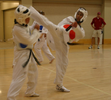




In this paper, we extrapolate the evolution of mobile devices in one specific direction, namely miniaturization. While we maintain the concept of a device that people are aware of and interact with intentionally, we envision that this concept can become small enough to allow invisible integration into arbitrary surfaces or human skin, and thus truly ubiquitous use. This outcome assumed, we investigate what technology would be most likely to provide the basis for these devices, what abilities such devices can be expected to have, and whether or not devices that size can still allow for meaningful interaction. We survey candidate technologies, drill down on gesture-based interaction, and demonstrate how it can be adapted to the desired form factors. While the resulting devices offer only the bare minimum in feedback and only the most basic interactions, we demonstrate that simple applications remain possible. We complete our exploration with two studies in which we investigate the affordance of these devices more concretely, namely marking and text entry using a gesture alphabet.


Screen-less wearable devices allow for the smallest form factor and thus the maximum mobility. However, current screen-less devices only support buttons and gestures. Pointing is not supported because users have nothing to point at. However, we challenge the notion that spatial interaction requires a screen and propose a method for bringing spatial interaction to screen-less devices.
We present Imaginary Interfaces, screen-less devices that allow users to perform spatial interaction with empty hands and without visual feedback. Unlike projection-based solutions, such as Sixth Sense, all visual "feedback" takes place in the user's imagination. Users define the origin of an imaginary space by forming an L-shaped coordinate cross with their non-dominant hand. Users then point and draw with their dominant hand in the resulting space.
With three user studies we investigate the question: To what extent can users interact spatially with a user interface that exists only in their imagination? Participants created simple drawings, annotated existing drawings, and pointed at locations described in imaginary space. Our findings suggest that users' visual short-term memory can, in part, replace the feedback conventionally displayed on a screen.



